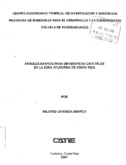Arboles nativos para diversificar cafetales en la zona Atlántica de Costa Rica
Date
2001Auteur
Linkimer Abarca, Mildred
xmlui.dri2xhtml.METS-1.0.item-location
Turrialba, Costa Rica
Type
Tesis de maestría
Metadata
Afficher la notice complèteAlternative title
Trees native to diversify coffee plantations in the Atlantic zone of Costa Rica
Description
Tesis (Mag. Sc.) -- CATIE, Turrialba (Costa Rica), 2001 132 páginas
Résumé
El objetivo del estudio fue contribuir al desarrollo de la caficultura sostenible identificando y caracterizando especies arbóreas nativas de uso potencial para diversificar cafetales de la zona Atlántica de Costa Rica. Para complementar los atributos claves que determinan la compatibilidad de árboles con café según la literatura, se entrevistaron a 95 caficultores para caracterizar el sistema café-árboles. Adicionalmente, se seleccionaron y priorizaron los atributos claves preferidos por los productores para el asocio de árboles con café, y se contrastaron con los atributos de la literatura. Posteriormente, se aplicaron los criterios de los productores y la literatura con sus respectivos pesos para identificar especies arbóreas con posible potencial para ser asociadas con café. Además se identificaron especies arbóreas nativas que fueron utilizadas en el pasado en cafetales de la zona. De las 62 especies encontradas en los cafetales, 17 fueron seleccionadas como promisorias para ser utilizadas en asocio con café. Entre ellas, las de mayor calificación y potencial para la zona Atlántica de Costa Rica fueron Inga sp., Psidium friedrichsthalianum, Spondias purpurea, Cordia alliodora, Cedrela odorata, Simarouba amara, Erythrina poeppigiana, Gliricidia sepium y Cassia spectabilis. No existieron diferencias entre la mayoría de especies seleccionadas al aplicar la lista de criterios de los productores vs. la lista de criterios de la literatura. The objective of the study was to contribute to the development of sustainable coffee production by identifying and characterizing trees that could be used to diversify coffee fields in the Atlantic region of Costa Rica. The coffee plantations and the diversity of associated trees were characterized by means of a survey. Interviews were conducted with 95 coffee farmers to determine both the benefits and probleMON of the trees present in their coffee plantations. In addition, the desirable attributes of trees as associates of coffee given by the literature were contrasted with those given by coffee farmers. Both literature and farmers criteria were then used to identify promising tree species for coffee. Furthermore, a list of native trees used in the past in coffee plantation was identified. Of the 62 species, 17 native tree species were classified as potentially compatible with coffee. Inga sp., Psidium friedrichsthalianum, Spondias purpurea, Cordia alliodora, Cedrela odorata, Simarouba amara, Erythrina poeppigiana, Gliricidia sepium y Cassia spectabilis were the tree species with the highest potential. Overall, the list of potentially compatible tree species derived from the attributes used by the literature agreed closely with that derived from farmers.
Keywords
Éditeur
Centro Agronómico Tropical de Investigación y Enseñanza (CATIE)
Collections
- Tesis [1392]


